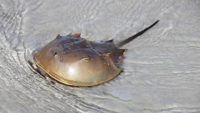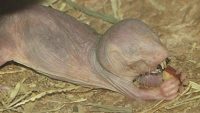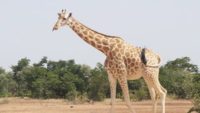The more we learn about life in the womb, the more the biblical truth is obvious. We are fearfully and wonderfully made right from the moment of fertilization. Read More
The bacterium has “remarkable” and “sophisticated” nano-scale electric motors …read more Source: creation.com
Camels can tolerate up to 30% loss of bodyweight by dehydration-twice that which would kill most other mammals. …read more Read more here: creation.com
By Troy Lacey The strange and unique horseshoe crab demonstrates design and yields medical benefits to humans and pets. …read more Source: AIG Daily
By Dr. Elizabeth Mitchell Naked mole-rats survive extreme oxygen deprivation in their crowded burrows by switching on fructose metabolizing machinery in their heart and brain cells. …read more Read more here: AIG Daily
Just when we thought we knew all the basics about the human body, anatomists made three surprising discoveries in 2016. The newfound human body complexity borders on science fiction. More… …read more Read more here: icr.org
Seminar by Chris Ashcraft Apologetics Symposium Cedar Park Church, Bothell WA January 6th, 2016 Description: What would the Earth be like without animals? They are indeed a very special part of the creation that provides endless fascination and brings much love into our lives. Previously unknown animals are discovered each year and the complicated world of these creatures has been made clearer by recent scientific discoveries. This presentation will focus on the amazing abilities of animals that are often a source of inspiration to engineers. Humans have long practiced biomimicry in an attempt to glean the ingenuity behind biological designs, [More]
“One of many marvels of design in nature.” Admin Unscrambling the mysteries by David Catchpoole Imagine a container filled with amorphous-looking bits of metal, plastic and some software chips. Could you imagine it breaking out as a fully-assembled scale model motor car? Then growing larger as it absorbs raw materials, as well as energy, from its surroundings? What sort of advanced software engineering would be required? As for any ideas of it being able to ‘marry’ another like itself, thus repeating the whole cycle by producing another container of metal, plastic and software … such notions could rightly be dismissed [More]
Creationists marvel that God has designed creatures both small and big to inhabit a variety of punishing habitats. These examples include the bacteria called Thermocrinis (in the geysers of Yellowstone) and bar-headed geese reaching extreme altitudes of 23,851 feet (7,270 meters). They can survive and flourish because the Lord Jesus has placed within their genome the specifications for traits that let them fill various ecological niches.More...
The human eye is, perhaps, one of the most obvious examples of design which defies the theory of naturalistic, unintelligent evolution. The more we learn about the eye the more unreasonable it is to suggest that it would originate in some kind of natural way. It is often said that a chain is only as strong as its weakest link. In many ways, vision is like a chain. It is a sequence of events where each step is dependent on every other complex component. If one single step is impaired, then vision as a whole suffers. Consider a [More]
By Howard Glicksman On today’s ID the Future, Your Designed Body co-author and physician Howard Glicksman talks with host and neurosurgery professor Michael Egnor about Glicksman’s new book, co-authored with systems engineer Steve Laufmann. Glicksman walks through a series of systems in the human body that are each irreducibly complex, and are each part of larger coherent interdependent systems. As Glicksman puts it, the human body is “irreducible complexity on steroids.” How could blind evolutionary processes, such as neo-Darwinism’s joint mechanism of natural selection working on random genetic mutations, build this bio-engineering marvel? Your Designed Body makes the case that [More]
By Andrew McDiarmid On this episode of ID the Future, the second in a series, host Andrew McDiarmid reviews three more displays of design in nature. Researchers in Scotland have shown that beavers, once considered by some as nuisances good only for their pelts, are actually great biodiversity engineers. The water lily is another marvel of hydraulic engineering that’s inspiring new designs for desalination plants. And the familiar walnut shell is made of cells interlocked more tightly than any 3-D puzzle ever invented, making it tough enough to need a hammer to open. It’s inspiring new packaging design ideas. See [More]
Join Origins host, Ray Heiple as he welcomes, Dr. Georgia Purdom for, “Design in DNA.” Genetics is astonishing evidence of a Designer, who created a marvelously complex, efficient “information system” for encoding life. The complexity of DNA is problematic for molecules-to-man evolution since the necessary changes are so implausible. The only reasonable explanation for all the information in DNA is that a Designer put the information in the original DNA sequences.
Gregor Mendel (father of genetics) and Charles Darwin (father of modern evolution) disagreed. Darwin claimed creatures could change into unlimited other creatures. Mendel’s discoveries suggest otherwise. See which idea science supports. Related Articles: Genetic variability by design (https://creation.com/images/pdfs/tj/j…) DNA: marvellous messages or mostly mess? (http://creation.com/dna-marvellous-me…) Splicing and dicing the human genome (http://creation.com/splicing-and-dici…) Incredible Kinesin! (http://creation.com/incredible-kinesin) New bacteria show ‘wonder upon wonder’ (http://creation.com/new-bacteria-show…) Design in living organisms (motors: ATP synthase) (http://creation.com/design-in-living-…)
Did you know that the moth smells with its antennae? Whether we look at moths, ants, bombardier beetles, dragon fly eyes, or even the brains of bees, the wonders of God’s design in the insect world are “clearly seen.” Listen: God’s Marvelous Insects | The Institute for Creation Research
By Ken Ham The more we study God’s creation, the more we realize how complex and beautifully designed it is. I was reminded of this truth when I learned about how the drab brown or pearly scales of the juvenile ocellated lizard change to a green and black adult lizard “using a computer-like process,” about God’s marvelous design in nature, especially in reptiles. Thanks for stopping by and thanks for praying,Ken This item was written with the assistance of AiG’s research team. …read more Source: Ken Ham AIG
We’ve seen in museums, textbooks, magazines, and in our biology classes that all life is made up of cells. Inside these cells are tiny, submicroscopic, molecular machines that function to sustain life. How do these biological machines work? And what does the Bible have to say about design in nature? Listen: Marvelous Molecular Machines | The Institute for Creation Research
By Karin Viet Animals fascinate humans. Whether playing with the family pet or gawking at the zoo wildlife, we marvel at the variety and complexity of these creatures. …read more Read more here: AIG Daily
Through eye-popping computer animation, based on recent scientific discoveries, this week’s episode explores amazing biological machines at work in our bodies. The Creation Magazine LIVE! TV program is a ministry of Creation Ministries International. With offices in seven countries and more PhD scientists than any Christian organization this program features cutting edge science that supports the Bible delivered in a non-technical, visually-rich, discussion-based format. Related Articles: ATP synthase: majestic molecular machine made by a mastermind (http://creation.com/atp-synthase) Incredible Kinesin! Biological ‘robots’ will blow your mind! (http://creation.com/incredible-kinesin) Meta-information – An impossible conundrum for evolution (http://creation.com/meta-information) Related Products: Codes and Creation DVD (http://creation.com/store_redirect.php?sku=30-9-559) [More]
“The more we document the marvels of design in ourselves and nature in general the more absurd the idea becomes this was all a product of chance. No one would dare think that the TV we watch or the computer we use arose by chance but there are those who think the human eye, far more complicated in design, was a product of random chance mistakes and mutations over millions of years … ridiculous. This quote from George Orwell is apropos for those teaching such nonsense: “Some things are so foolish that only an intellectual could believe them, for [More]
“The incredible process of metamorphosis, changing a caterpillar to the beautiful monarch, is astounding in it’s complexity and defies any evolutionary explanation. It is one of the most powerful arguments for creation I know of.” Admin A monarch’s development from caterpillar to adult and its incredible ability to migrate clearly display the Creator’s design. What animal has a brain the size of a pinhead and yet can pinpoint a location 3,000 miles (4828 km) away and navigate there with an accuracy of 100 feet (30.5 m)?1 It is the most famous butterfly in North America—the monarch. But the winged adult [More]
“I’ve posted a number of these articles about marvels of design which occur throughout nature yet no matter how many examples are given evolutionists still insist they are just products of blind random chance … how foolish can you get.” Admin For decades, human design engineers have been laboring to make more efficient machines, like propeller blades that produce steady airflow patterns. Our thinking has been fixed on the idea that smooth surfaces are the best basic form, but studies on whales and dolphins are changing that. A whale flipper has a bumpy edge. After incorporating some bumpy, irregular features into [More]
“Another incredible marvel of design that only an intelligence far greater than ours could have produced.” Admin Human eyes are well-designed to see objects using light transmitted through air, but not through water, because light travels at a different speed through the two media. However, intertidal-dwelling marine mollusks called chitons can see equally well in both environments. How did they acquire this unusual ability? Chitons scour intertidal rocks for algae meals. Eight integrated shell-plates cover their backs, and a muscular foot allows them to cling with surprising strength to the rocks they traverse. A recent study explored their unique dual-mode [More]
“Just one more of many marvels of design in nature.” Admin The humble fly hovering over a garbage can is routinely capable of some high-speed aeronautic manoeuvres that have long boggled the minds of aircraft designers and engineers. If a male fly chasing a potential mate sees her change course ever so slightly, he will respond with an appropriate change of his own in just 30 milliseconds! It has long been known that the amazing stability of flies as they zip around has a lot to do with the two tiny club-shaped ‘balancing organs’ they have, called halteres (see Figure [More]
“Excellent article. How anyone could think that such a super sophisticated visual system could be the product of random chance is beyond me, since its complexity fairly shouts that it had to have been designed. If you would like to see more marvels of design watch the video God Of Wonders Here” Admin The fine nanorod structure of the mantis shrimp eyes allow it to rotate the polarization across the spectrum. This could help DVD players to process much more information. …read more Read more here: creation.com
“One more marvel of design that clearly testifies to Gods handiwork.” Admin Bees can solve complex mathematical problems that would normally keep computers busy for days, according to a new report from UK researchers.1 Through careful observation, University of London scientists have determined that bees routinely solve the “traveling salesman problem,” in which a subject must determine the shortest route between multiple destinations in order to conserve energy. But the scientists don’t know how the bees do it with a brain the size of a grass seed. “Bees learn to fly the shortest possible route between flowers even if they [More]
“One more marvel of design in nature.” Admin Certain gecko lizards can see color in dim light. That means these geckos’ eyes are about 350 times more sensitive than human eyes, which see only black and white in the same conditions. Can evolution account for the origin of the remarkable machinery that enables these nocturnal creatures to see so well? Scientists studying the helmet gecko’s eyes found distinct concentric zones, each with a different refractive power. Geckos also have a much higher density of oversized cone cells in their retinas that are responsible for detecting specific light wavelengths. In their [More]




























